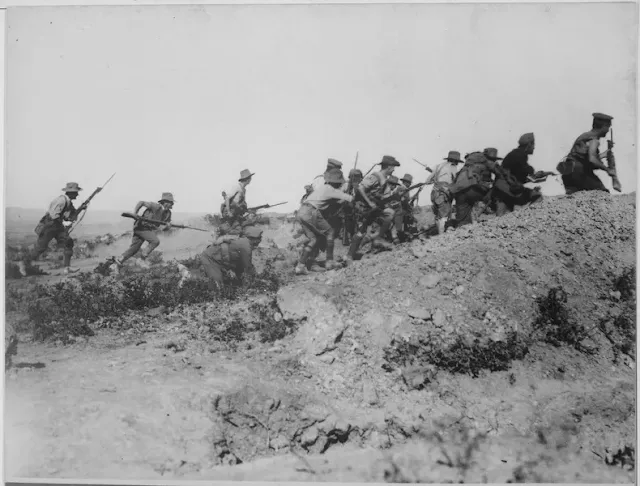Introduction to the Battle of Gallipoli
 |
| "Allied troops disembark at Gallipoli on April 25, 1915. The campaign marked the start of a prolonged and bloody conflict that shaped the course of World War I." |
The Battle of Gallipoli, one of the most significant Major Battles of World War I, took place between April 25, 1915, and January 9, 1916. Fought on the Gallipoli Peninsula in modern-day Turkey, this campaign involved the Allied Powers' attempt to secure the Dardanelles Strait. It is remembered for its military failures and its profound influence on the national identities of the involved nations, particularly Australia, New Zealand, and Turkey.
The Strategic Importance of the Gallipoli Peninsula
Why Was the Dardanelles Strait Critical?
The Gallipoli Campaign centered around control of the Dardanelles Strait, a narrow waterway connecting the Aegean Sea to the Sea of Marmara. For the Allies, securing this passage would provide a direct link to Russia, enabling better communication and supply routes. It would also deal a severe blow to the Ottoman Empire, a key ally of the Central Powers.
The Allied Plan: Naval and Land Invasions
Winston Churchill's Ambitious Strategy
In early 1915, Winston Churchill, then First Lord of the Admiralty, proposed a naval assault followed by a land invasion to capture Constantinople (modern-day Istanbul). This would potentially knock the Ottoman Empire out of the war and open up a southern front against Austria-Hungary.
The Failed Naval Assault
The initial plan was a naval attack in March 1915. However, this attack failed, as Ottoman forces had heavily fortified the strait with mines and artillery, sinking several Allied ships and forcing a change in strategy.
The Land Campaign: The ANZACs and Other Allied Forces
The Gallipoli Landings (April 25, 1915)
After the naval failure, the Allies shifted their focus to a land invasion. British, French, Australian, New Zealand (ANZAC), and Indian troops were deployed to capture key positions on the Gallipoli Peninsula. The landings, particularly at ANZAC Cove, met with fierce resistance from well-prepared Ottoman forces.
The Role of Mustafa Kemal in Defending Gallipoli
The Ottoman defense, led by Mustafa Kemal (later known as Atatürk), played a crucial role in repelling the Allied assault. His leadership during pivotal battles like Chunuk Bair and the defense of Sari Bair was instrumental in the Ottoman victory.
The Brutal Reality of the Gallipoli Campaign
Harsh Terrain and Stalemate
The geography of Gallipoli, characterized by steep ridges and dense scrub, made movement difficult for the Allied forces. What was expected to be a quick campaign turned into a prolonged stalemate, with trench warfare taking hold.
Disease, Scarcity, and High Casualties
Soldiers on both sides faced appalling conditions. Heat, cold, and lack of proper supplies led to widespread disease, particularly dysentery. Both the Allied and Ottoman forces suffered heavy casualties, but the Allies were unable to break through Ottoman lines.
The Withdrawal: The End of the Gallipoli Campaign
The Decision to Evacuate
By late 1915, the Gallipoli Campaign was deemed a failure. Allied forces began a carefully planned evacuation in December 1915 and January 1916. Despite the campaign's failures, the withdrawal was executed with minimal losses.
Consequences of the Gallipoli Defeat
The failure at Gallipoli had significant political and military consequences. Winston Churchill resigned from the Admiralty, and the campaign became a symbol of poor planning and underestimating the enemy. However, the lessons learned at Gallipoli would influence later strategies in World War I.
Gallipoli's Lasting Legacy: National Identity and Global Impact
ANZAC Day: The Birth of National Consciousness for Australia and New Zealand
The bravery of the ANZAC soldiers during the campaign has become a central part of the national identity for both Australia and New Zealand. Every year on April 25, ANZAC Day commemorates the sacrifices made at Gallipoli, marking it as a key moment in their histories.
Gallipoli and the Rise of Mustafa Kemal Atatürk
For Turkey, the Gallipoli Campaign is equally significant. Mustafa Kemal's successful defense of the peninsula set him on the path to becoming the founder of modern Turkey. Gallipoli is remembered as a symbol of Turkish resilience and pride.
Conclusion: The Battle of Gallipoli’s Impact on World War I
The Battle of Gallipoli was a costly and tragic chapter in World War I. Though the campaign failed to achieve its strategic goals, it had a profound impact on the nations involved. The human cost was enormous, with over 100,000 soldiers losing their lives. However, the campaign's legacy endures in the national consciousness of Turkey, Australia, and New Zealand, and it remains a significant event in the history of the Great War.

Post a Comment